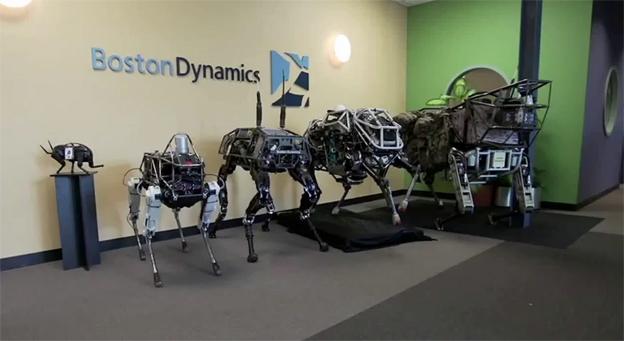Taking the robot dog for a walk
- Published
- comments
Google's new robot, Spot
It's a video which is bound to go viral, external. Spot sets off down an office corridor, and then out into the open air. At various points, for no apparent reason, people approach him and try to kick him over - he staggers back and then resumes his progress.
And no, there are unlikely to be protests to the RSPCA because Spot is actually a robot dog. It is the latest, most sophisticated creation of a company called Boston Dynamics. Spot follows in the footsteps of Big Dog, which as its name suggests was a rather larger but cruder robot seen rampaging across the Massachusetts countryside in another video, external which since 2008 has had more than 16 million YouTube views.
Spot looks a little friendlier than his predecessor and appears to have pretty sophisticated on-board directional systems of the kind that guide Google's driverless car through traffic. But one question bugs me as I look at him - what is he for?
That seemed fairly obvious with Big Dog because that was a project funded by Darpa, the US military's research division which also played a major part in the development of the internet. One can easily see how robots like this could become the soldiers of the future, doing everything from mine-clearing - which some automated devices can already undertake - to actual combat. After all, what is a cruise missile or a drone but a robot, albeit one that is for now under human control?
But last year Boston Dynamics was acquired by Google as part of the search giant's spending spree which saw it snap up half a dozen robotics companies. The new owners immediately stated one clear principle - its robots would not be used for military ends. With fears mounting about Google's wealth, power and knowledge of every aspect of our lives, you can understand why it wanted to give that assurance.

Spot stands next to his predecessors at Boston Dynamics Massachusetts base
So what does it want to do with robots like Spot? In the short term you can see that the research fits with the work of the driverless car team run out of the Google X division, but that too is currently a blue sky project, with any products quite a long way away.
Work on robotics may also mesh with the work going on at Nest, the smart home business, and the research at the British artificial intelligence company Deep Mind, both of which were also bought by Google last year.
For now, though, Boston Dynamics, created by MIT scientists, Nest, run by the former Apple executive Tony Fadell, and Deep Mind, under Demis Hassabis, have all been guaranteed a large measure of independence from the mother ship in California.
There are signs that this policy may not last, and that a bit more integration of this patchwork of interests may be on the cards. Tony Fadell, a man with a track record of turning out consumer products rather than just blue sky thinking, has been put in charge of the ailing Google Glass division.
For now, though, the Boston Dynamics roboticists far away on the east coast of the United States appear at liberty to carry on their research without the pressure of shipping a consumer product. Watch out, though - Spot is getting smarter and may one day decide he's had enough of getting kicked around.